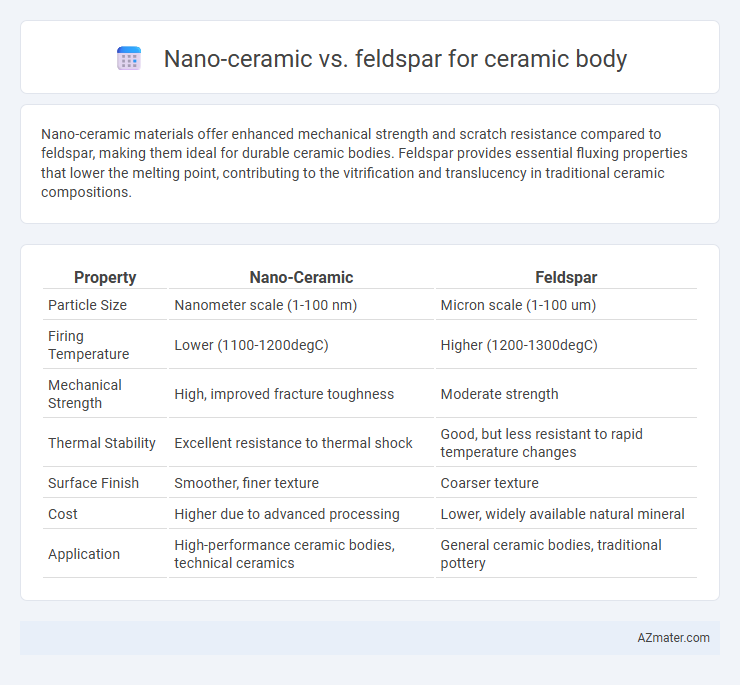Nano-ceramic materials offer enhanced mechanical strength and scratch resistance compared to feldspar, making them ideal for durable ceramic bodies. Feldspar provides essential fluxing properties that lower the melting point, contributing to the vitrification and translucency in traditional ceramic compositions.
Table of Comparison
| Property | Nano-Ceramic | Feldspar |
|---|---|---|
| Particle Size | Nanometer scale (1-100 nm) | Micron scale (1-100 um) |
| Firing Temperature | Lower (1100-1200degC) | Higher (1200-1300degC) |
| Mechanical Strength | High, improved fracture toughness | Moderate strength |
| Thermal Stability | Excellent resistance to thermal shock | Good, but less resistant to rapid temperature changes |
| Surface Finish | Smoother, finer texture | Coarser texture |
| Cost | Higher due to advanced processing | Lower, widely available natural mineral |
| Application | High-performance ceramic bodies, technical ceramics | General ceramic bodies, traditional pottery |
Introduction to Nano-ceramic and Feldspar in Ceramic Bodies
Nano-ceramic materials, composed of ultra-fine particles typically less than 100 nanometers in size, enhance ceramic bodies by improving mechanical strength, thermal stability, and surface finish. Feldspar, a natural aluminosilicate mineral rich in potassium, sodium, and calcium, acts as a flux in ceramic bodies, lowering the melting temperature and aiding vitrification during firing. Combining nano-ceramic additives with feldspar can optimize the microstructure and performance of ceramic composites, resulting in increased durability and refined aesthetics.
Material Composition Overview
Nano-ceramic bodies typically contain ultra-fine ceramic particles such as alumina and silica, which enhance mechanical strength and thermal stability. Feldspar-based ceramic bodies rely heavily on natural feldspar minerals rich in potassium and sodium aluminosilicates, acting as fluxing agents to lower melting temperatures during firing. The nano-ceramic composition offers improved homogeneity and densification compared to feldspar, which provides traditional vitrification properties essential for conventional ceramic production.
Manufacturing Processes Compared
Nano-ceramic materials in ceramic body manufacturing offer enhanced particle dispersion and finer microstructure control compared to feldspar-based bodies, leading to improved sintering kinetics and mechanical strength. Feldspar, traditionally used as a flux in ceramic formulations, requires higher firing temperatures and longer cycles due to its coarser particle size and slower melting behavior. The advanced processing techniques for nano-ceramics enable lower energy consumption and faster industrial throughput, making them more efficient for high-performance ceramic production.
Mechanical Strength and Durability
Nano-ceramic materials exhibit significantly higher mechanical strength and durability compared to feldspar-based ceramic bodies due to their ultra-fine particle size and enhanced particle packing density, which reduces porosity. Feldspar, commonly used as a flux in ceramic bodies, provides moderate strength but is more prone to micro-cracking and wear under mechanical stress. The superior toughness and impact resistance of nano-ceramics make them ideal for high-performance applications requiring long-lasting durability and structural integrity.
Aesthetic Properties and Color Stability
Nano-ceramic materials in ceramic bodies offer superior aesthetic properties due to their uniform particle size, resulting in enhanced translucency and a smoother surface finish compared to feldspar. Feldspar, while traditionally valued for its fluxing properties, can exhibit less color stability over time due to its crystalline structure, which may cause subtle color shifts under prolonged exposure to heat and light. Nano-ceramics maintain consistent color stability, preserving the vibrant hues and gloss of ceramic surfaces even after extensive firing cycles.
Thermal Properties and Resistance
Nano-ceramic materials in ceramic bodies exhibit superior thermal shock resistance due to their fine particle size and uniform microstructure, which enhance heat distribution and minimize thermal expansion. Feldspar, commonly used as a flux in ceramic bodies, provides moderate thermal properties but is more prone to thermal cracking owing to its higher porosity and coarser grain size. The incorporation of nano-ceramic particles significantly increases thermal stability and mechanical strength, making them preferable for applications requiring high thermal resistance.
Cost Effectiveness and Production Efficiency
Nano-ceramic additives enhance ceramic bodies by improving mechanical strength and reducing firing temperatures, leading to significant energy savings and shorter production cycles. Feldspar, commonly used as a flux, lowers melting points but may require higher firing temperatures compared to nano-ceramic mixes, increasing energy consumption. The integration of nano-ceramics results in cost-effective manufacturing through reduced raw material usage, less wastage, and improved throughput, outperforming traditional feldspar-based formulations in production efficiency.
Applications in Modern Ceramics
Nano-ceramic materials exhibit superior mechanical strength, thermal stability, and wear resistance compared to feldspar, making them ideal for high-performance applications such as aerospace components and advanced electronics. Feldspar remains a key fluxing agent in traditional ceramic bodies, contributing to vitrification and melting behavior, which enhances the density and durability of sanitaryware and tiles. Modern ceramic manufacturing increasingly integrates nano-ceramics to optimize performance characteristics while leveraging feldspar's proven role in cost-effective, large-scale production.
Environmental Impact and Sustainability
Nano-ceramic materials offer increased durability and reduced raw material consumption compared to traditional feldspar in ceramic bodies, lowering environmental degradation. Feldspar extraction and processing often result in habitat disruption and higher carbon emissions due to energy-intensive mining operations. Utilizing nano-ceramics promotes sustainability by enabling thinner, lighter ceramic products with extended lifespan, thereby minimizing waste and resource depletion.
Conclusion: Choosing the Right Material for Your Ceramics
Nano-ceramic offers superior mechanical strength and enhanced durability compared to feldspar, making it ideal for high-performance ceramic bodies. Feldspar provides excellent fluxing properties and contributes to a balanced melting behavior, beneficial for traditional ceramics with moderate strength requirements. Selecting the right material depends on the desired final product characteristics--opt for nano-ceramic for advanced durability and feldspar for cost-effective, reliable fluxing in ceramic formulations.

Infographic: Nano-ceramic vs Feldspar for Ceramic body
 azmater.com
azmater.com